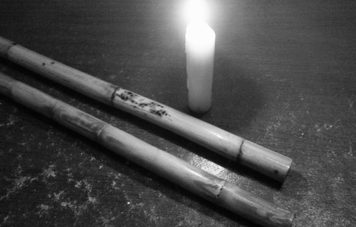It is quite a paradox that relaxation is among the secrets to speed and power in the practice of martial arts. Among escrimadors, the fastest I know are those who have gained excellent command of this elusive attribute.
Ireneo Olavides, the protégé of the late juego todo champion Jose D. Caballero and the founder of Eskrima De Campo JDC-IO (JDC-IO stands for “Jose D. Caballero,” and “Ireneo Olavides) could strike like greased lightning. Olavides revealed that the secret of his speed is relaxation – a principle he borrowed from tai chi chuan. This Chinese internal martial art teaches relaxation through moving and still meditation.
I have observed too that his on-guard position (right hand holding the stick with the inside part of the shaft resting lightly on the left tricep and the left hand touching the crook of the right elbow) is a very relaxed stance designed for the optimum delivery of the system’s first strike – a rebounding horizontal blow from left to right.
The principle of relaxation is also evident in the way Olavides holds his weapon. He explained that the proper way of holding the stick should be soft yet hard. “If you have become one with the stick, then you don’t treat it as a slave, gripping it desperately as if it would slip out of your hand any moment,” I remember him saying during our first meeting.
Stillness, both mental and physical is essential in understanding relaxation as applied to combative movements. It is therefore no surprise that meditation training is necessary for the mastery of any martial art.
With the Philippines being under Spain for almost four centuries, the practice of meditation in Filipino martial tradition shows heavy influence of Catholicism. Eastern forms of meditation focus on emptying the mind, with the practitioner allowing himself to just exist, to simply be. Another objective is to be aware of and to control one’s internal energy. Not so with Western forms of meditation. In the latter, the Christian version in particular, the goal simply is to contemplate on man’s relationship with God.
But despite the disparity in goals, western and eastern forms of meditation share common components on how to attain an altered state and deep relaxation. These commonalities are: a quiet place (an environment with as minimal distractions as possible), a mental device (to neutralize the bombardment of external and unwanted thoughts there must be a constant stimulus.
This could be fixed gazing at an object or a sound, word or phrase repeated silently or aloud), a relaxed breathing pattern (deep abdominal breathing promotes relaxation and pumps more oxygen into your system), a letting go attitude (a ‘let it happen’ mindset allow things to progress naturally) and lastly, a comfortable position (any comfortable position will do so long as you will not fall asleep.)
In the case of standing meditation, silence, stillness and gravity allow the practitioner to become more aware of his body, “While you are standing, your muscles have to work against gravity to keep your body up. This effort helps you become aware of bad alignments,” wrote internal arts master Kumar Frantzis in “How Standing Practices Build Chi.”
The employment of relaxation training is a mark of a highly evolved martial art whether oriental or occidental. Aldo Nadi, considered among the greatest fencers of all time, in his book “On Fencing,” wrote of one master’s method of teaching relaxation, it reads, “For example, to teach him how to relax, the master would put him on guard, ordering him not to move. He would then go around the Salle to watch other pupils at work.
After two, three or even four minutes, he would come back to his favorite who was still on guard. With the tips of his five fingers the master would touch his arm: Your arm is tense. You will never be a fencer. Get out.” The lesson was over, and [Alphonse] Kirchhoffer would leave the Salle in despair… He was back promptly the day after. From this anecdote you should realize the importance of relaxation. It is the source of all energy. No fencer can afford to be continuously tense.”
Martial arts legend Dan Inosanto referred to relaxation in combat as ‘neuromuscular perceptive movement’ as taught by his mentor Bruce Lee. In his book “Absorb What is Useful” (1982), he recalled Lee’s advice on the matter, “Bruce used to stress, ‘Eliminate all unnecessary motions and muscle contractions which slow and fatigue without accomplishing any useful purpose. Much energy is wasted by the unrelaxed opposing muscles, resisting the movement.
Learn and feel proper contraction and recovery. Otherwise, the physiological engine is racing but the brakes are on. Apply only those muscles required to perform the act, using them as economically as possible and not using the other muscles to perform movements which do not contribute to the act or which interfere with it. Expend both the mental and physical energy constructively.”





















